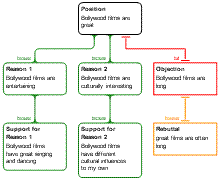The Science Of Scientific Writing .Course Introduction. Overview : Content and Packaging : Enriched Blueprints : Compartmentalisation : Course Mechanics
OVERVIEW: The way to well-written science
PART I: Paragraphs and Sentences
SET A: Paragraphs: The Maps Behind Them
SET B: Paragraphs: Using Maps to Meet Readers' Expectations
SET C: Paragraphs with Something Extra: Points and Tails
SET D: The Generic Section: Expectations and Maps as Blueprints
SET E: Scientific Sections: The Methods and Results
SET F: Scientific Sections: The Discussion
SET G : Scientific Sections: The Introduction
SET H : Sentences
SET I : The Paper as a Whole
PART II: The Paper and its Sections
SET 1: Argument Parts
SET 2: Indicator Words
SET 4: Locating Arguments in Prose
SET 5: Rationale's Essay Planner
SET 6: Evidence in Arguments: Basis Boxes
Synthesis 1: Position-Early Paragraphs
Synthesis 2: Position-Final Paragraphs
Synthesis 3: Writing a Discussion I
Synthesis 4: Writing a Discussion II
(Note Part II currently focusses mainly on argumentation, using the original Rationale training exercises. It will soon be revised (Q1 2009) to follow the schema set out in the course Introduction. Many of the examples are general, non-scientific examples, and these will gradually be replaced.)
Part II: Arguments in scientific writing Most scientific papers have, at their heart, an argument. They put forward some specific case of this generic argument: The results provide new information that significantly modifies (or confirms) our existing understanding of one or more scientifically important topics. Within this overall framework will also find many sub-arguments, such as (generically expressed):
Young scientists are often shocked to hear that argumentation plays such a prominent role in scientific writing. They often feel that are involved in uncovering "reality" and that the data should basically "speak for themselves". If they are advanced enough to realise that science is more concerned with "models" than reality, then they probably feel that the focus should be on how to best present their "new model". But while this may play some part in a paper, a more important goal is persuading the reader that the old model is in need of some fixin' in the first place. I got my
own wake-up call about this aspect of science when, after a conference
presentation early in my career, a colleague took me to task about the
reliability of my data. Writing a persuasive argument of any type is a highly sophisticated skill. Scientific arguments are often particularly difficult because of the intellectual challenge and wide-ranging nature of their content. To reduce these problems, and to increase the efficiency of writing, it is has become increasingly obvious in recent years that it is wise to approach argument writing in two stages:
Argument
diagramming or mapping is a rapidly developing art and in this course
we will use the pre-eminent software in this field, Rationale. In this part of course we will first learn how to "map" an argument and then learn how to use it as a guide to our prose. By becoming familiar with the inter-relationship of map and argumentative prose you will:.
These will be the main outcomes of the course. But we will also look at some "higher skills" whereby good writers:
Proceed to the exercises of Set 1.
|
......

 So instead of basking in the glow of a well-prepared talk, I found myself
adrift in unfamiliar territory where what was called for was not the logical
mind of a scientist but the poise and wiles of a debater.
So instead of basking in the glow of a well-prepared talk, I found myself
adrift in unfamiliar territory where what was called for was not the logical
mind of a scientist but the poise and wiles of a debater. Argument mapping works rather like a structured form of brainstorming,
and is unique amongst such "pre-writing" approaches in that
it offers very useful insights into how to proceed with prose composition.
Argument mapping works rather like a structured form of brainstorming,
and is unique amongst such "pre-writing" approaches in that
it offers very useful insights into how to proceed with prose composition.